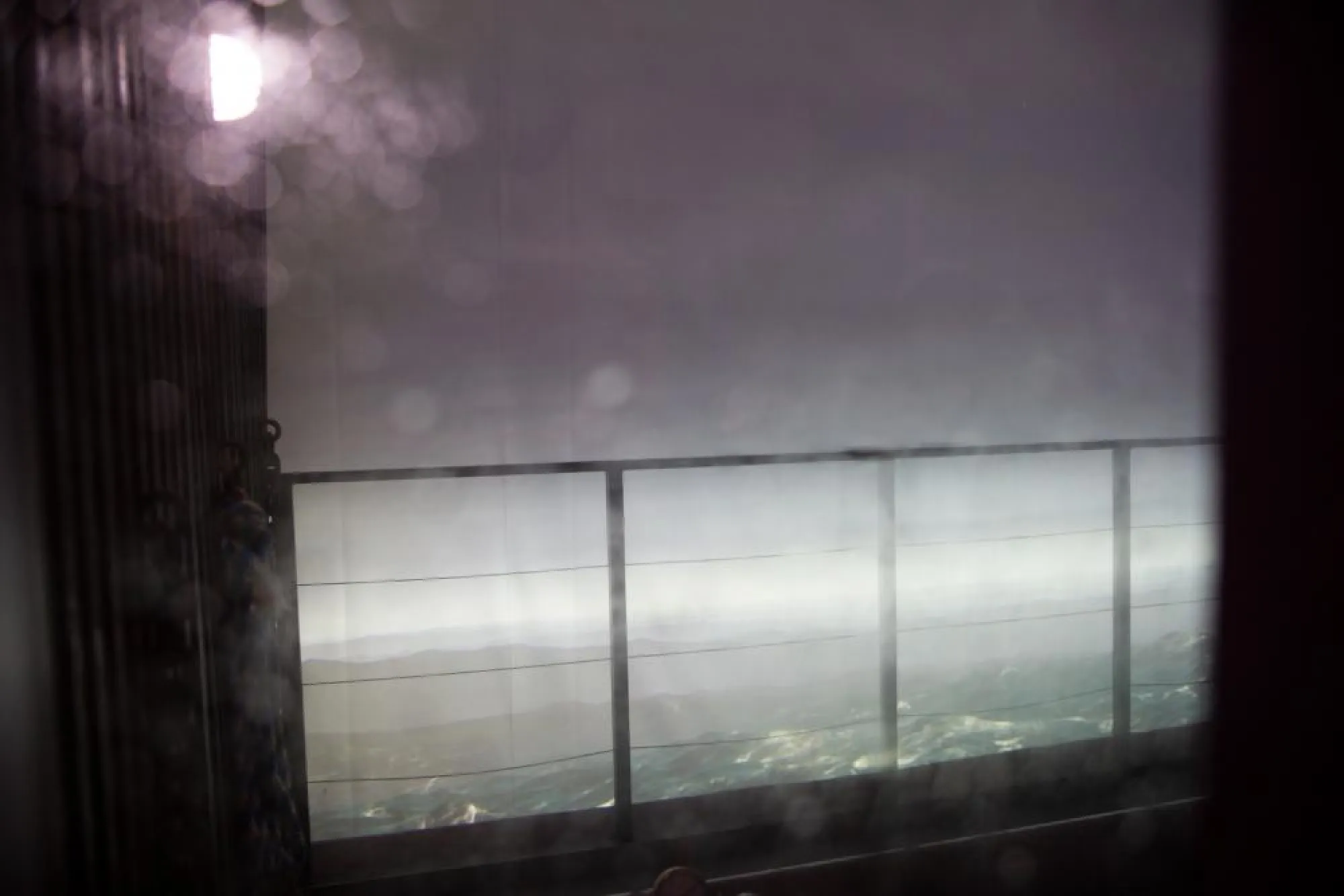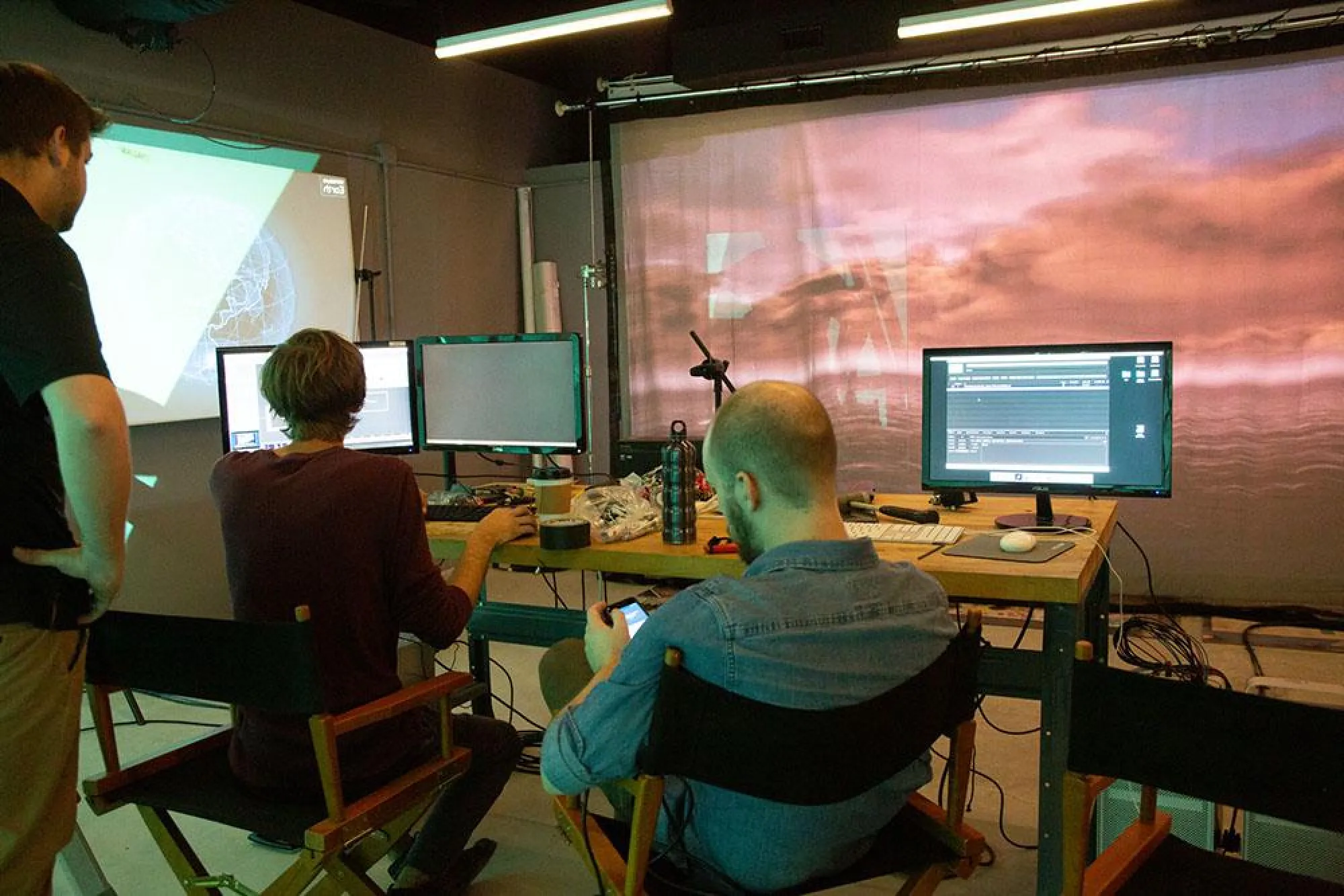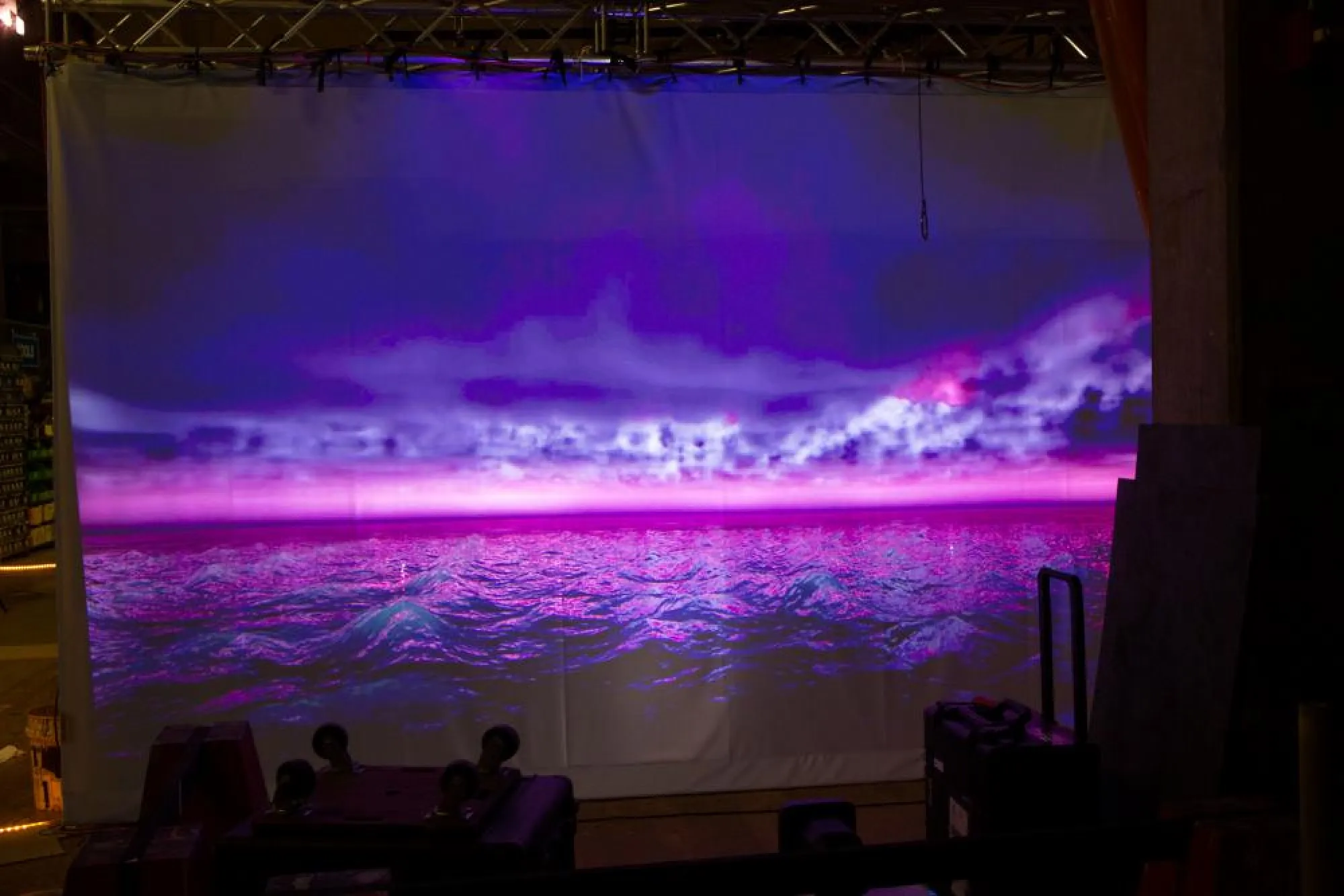Escaping Doom
Pandemic disrupts ambitious plans for interdisciplinary escape room project designed in partnership with Planet Texas 2050

Story and images by Jen Reel
When South by Southwest (SXSW) canceled its spring 2020 events because of COVID, College of Fine Arts faculty members J.E. Johnson and Sven Ortel knew that their students’ escape room was in jeopardy. The room, which had been fabricated to simulate an extreme event endangering society, was being sidelined by a real event endangering society.
Just a few months earlier, Resilience Entry (the escape room’s official name) had a successful first public showing. Designed and built by more than 75 students in six College of Fine Arts courses during the fall 2019 semester, it opened in early December for touring and beta testing. Although Resilience Sentry followed the general constructs of an escape room—a team works together to find clues, solve puzzles and accomplish tasks within a given time frame—its storyline about climate change and intense weather elevated its appeal to a wider audience.
The story had taken shape through a partnership with Planet Texas 2050, The University of Texas at Austin’s multidisciplinary program aimed at developing research and strategies to prepare Texas for extreme climate change and population growth. Scientists and emergency responders and planners were intrigued by Resilience Sentry as a means to educate and engage the public with climate change, and the team collaborated with UT researchers and scientists at the UT Marine Science Institute in Port Aransas to flesh out story details. SXSW would be the opportunity to share the project’s story with more people and potentially attract more financial support—and consequently move it out of its temporary spot in the Texas Performing Arts (TPA) scenic shop and into a more permanent space, where it could evolve and continue its educational outreach. Without SXSW’s exposure, and during a pandemic when gathering a group in an enclosed space would be extremely dangerous, the future of Resilience Sentry was unknown.
“Even though we can’t gather together, now’s the time we can reflect on the work,” says Ortel, “and consider how to better create these experiences as best we can, when we can.”
***

The origins of Resilience Sentry can be traced back to late 2018. Ortel, who has appointments in the departments of Arts and Entertainment Technologies (AET) and Theatre and Dance (TAD), had read about an escape room project and thought the combination of game design and stagecraft was a perfect genre for the College of Fine Arts.
He shared his idea with professor and game designer Michael Baker, who was serving as AET interim chair and gave Ortel the green light to move his idea into curriculum. Originally, they thought the room would be more digital than physical, but they changed course after conducting more research.
“A large part of the joy of solving these puzzles comes from doing something with your hands and being able to walk around and interact with physical things,” says Ortel.
The revelation led him to tap Johnson, the TPA shop supervisor and instructor for TAD and AET, as his co-leader of the project. But Ortel knew that to bring this experience to life, they also needed a good story.
“I wanted it to be something that’s relevant and happening on campus and something that UT and our students care about,” says Ortel. “I immediately thought of working with Planet Texas.”
Ortel, who describes himself as “a bit of a weather nerd,” wanted extreme weather and climate change to be at the heart of the story. The original idea was to have players serve as trapped scientists on a research station in the Gulf of Mexico in the year 2040, and they need to send vital data to the mainland and escape before a major storm hits. But Ortel said the UT researchers and scientists that Planet Texas connected to them helped shape the initial story to reflect a more probable scenario. For example, satellite navigation would be out—too much space junk in 30 years would make it unreliable. And housing scientists at a weather research station as Ortel was proposing would probably be too expensive—most likely artificial intelligence and a network of sensors on buoys would be needed.
Troy Kimmel, a broadcast meteorologist and UT lecturer who regularly teaches Weather and Climate and Severe and Unusual Weather in the College of Liberal Arts, also explained rapid intensification to Ortel and Johnson, noting how some cyclones can intensify dramatically in a very short period, leaving little response time.
“The moment we had the conversation, the whole momentum and idea of what’s driving the players changed significantly,” says Ortel. “It wasn’t that they were escaping their current situation: It became a mission to go there, find out what’s wrong, fix it and get out again.”

The team connected with other scientists and researchers, and after a conversation with Professor Tracy Villareal, an oceanographer and faculty member in the Department of Marine Science, they realized how little they knew about life and work on the Gulf Coast. Villareal invited the crew to do a site visit at the Marine Science Institute in Port Aransas in November, where they toured the institute, shared their project plans and spoke with researchers about their work. The scientists even donated artifacts and lab gear that could be integrated into the escape room for extra authenticity.
“Suddenly everything we had been speculating about became more grounded in reality,” says Ortel. “These researchers devoted their lives to climate science, and the facility itself had just finished a two-year restoration after suffering major damage from Hurricane Harvey in 2017.”
After spending the spring and summer researching and refining their escape room plans, they were ready for students to begin building last fall.
***
Coordinating 75 students across six classrooms for one project is no small feat.
Although most were registered undergraduate and graduate College of Fine Arts students, many were also engineering majors—a common occurrence in Johnson’s fabrication classes. Johnson has a long history of writing curriculum with a maker mentality and collaboration as foundation. He also uses “strengths finder” assessment tools to help his students develop a sense of agency and how to use their talents when working on their own and with their peers. Together with Ortel, who also has numerous cross-disciplinary projects under his belt, they were able to work with other faculty members to create a workflow that connected the courses to the escape room goal, and to build efficient teams of students. The result was Resilience Sentry, not only a triumph in escape room design, but an immersive form of storytelling that emotionally connects us to real-world issues.
When first entering the room, one could be forgiven for forgetting the impending doom of the situation as the beauty of the design felt peaceful—at first. A warm red glow from emergency lights blanketed the room while a soft rain could be heard. A large picture window streaked with raindrops offered an infinite view of steady waves and glimpses of a storm far off in the distance. But quickly it became apparent that the storm was getting closer. The thunder was getting louder, the rain harder, the waves choppier. Flashes of intense lightning would fill the room. The sense of urgency was created for the players, who had to work together to solve a series of puzzles and clues placed throughout the room. Power had to be restored, buoys recalibrated, information reported back to the mainland. And of course, all within enough time to escape before it was too late. Resilience Sentry was an extraordinary on-campus project, with immense potential outside the university as well.
Having successfully finished the prototype that December, they were excited for the spring and summer semesters. Increased support and funding would mean potentially adding briefing and debriefing rooms to Resilience Entry—a way to bookend the experience and provide more of the research data on climate change and Texas weather. Assistant Dean for the School of Design and Creative Technologies Doreen Lorenzo was set to moderate a featured session at SXSW Interactive called “Escaping Doom: Transforming Science into Experience” and help introduce Resilience Sentry to the world. That day never came.
***
“Since the pandemic has come along, it’s given us the opportunity to go small,” says Johnson, who has had to adapt like everyone else to our current realities.
Like many Fine Arts courses, Johnson and Ortel’s classes had to be dramatically altered. No shoulder-to-shoulder work days of sharing tools and shop space. After SXSW was canceled and spring courses moved online, Resilience Sentry was dismantled and stored away, and the faculty members are not sure whether it might be able to return in a post-COVID world.
But Johnson, Ortel and other faculty members have been working hard to continue creating hands-on, collaborative learning and storytelling experiences in a socially distanced world.
“As the pandemic became an unavoidable reality in our lives, I started to think about how else we could tell stories if the audience is not in the room with us,” says Ortel. He partnered with the Texas Immersive Program in the Stan Richards School of Advertising & Public Relations on the project “Eyes on the Sky.” Ortel built on what he’d learned with Resilience Sentry to build a narrative around space debris and how it will affect our lives and future. The project also explores how our behavior as stewards of our planet is vital to our survival.
Johnson had planned to co-teach a class this fall with Karen Maness to build robots for a Theatre and Dance production of Elizabeth Meriwether’s Heddatron. But when the production was canceled, they pivoted and partnered with a local elementary school to create a whole new robot-themed experience for their students that could be taught remotely.
Johnson, Maness and their students are working through Zoom meetings with an after-school student maker club run by Eva Rosenthal, a teacher at Metz-Sánchez Elementary. They’ve put together a curriculum for her students to design robots that the UT students will build, and they have set up a curbside pickup system so students can access tools and electronics on campus.
The goal is not just to build tabletop robots designed by the children, but to allow for students to control them remotely. So although it will feel similar to, say, controlling a video game, the difference is that a person with whom they’ve developed a relationship over the course of the semester built that physical object for them. Johnson compares it to controlling a Mars rover remotely.
Johnson says the restrictions imposed by the pandemic have forced him to look at what’s really important about what he teaches and why, and how that can be done through both large, collaborative hands-on learning courses like the escape room, and online ones like this robot class.
“It’s about creative confidence and helping students to actualize their creativity, to feel like they can contribute in meaningful ways to the world and to art,” says Johnson. “That’s really what it’s about.”

